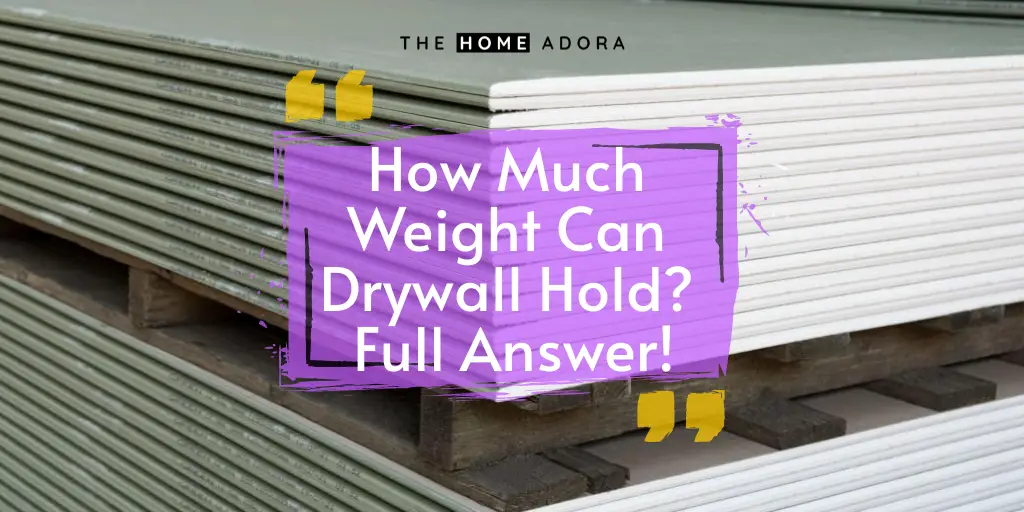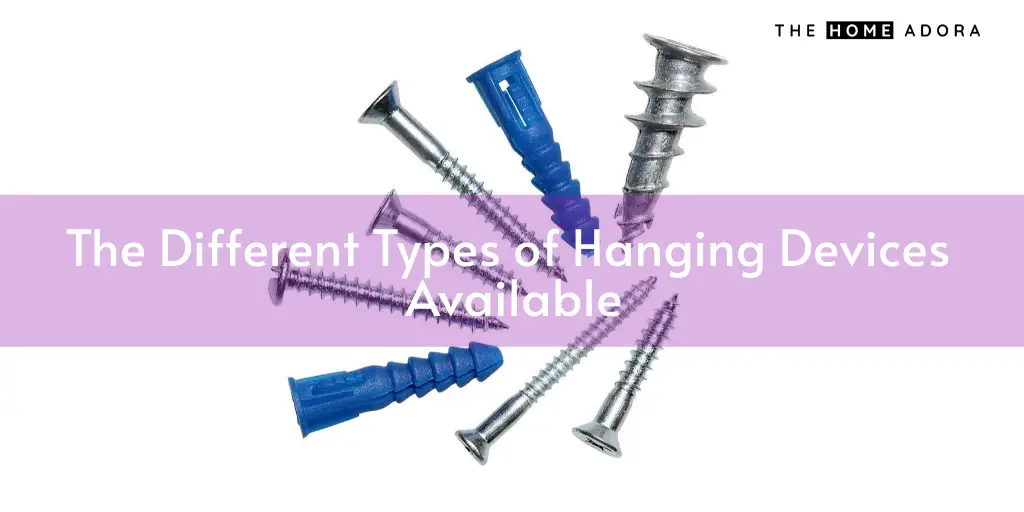Do you want to know “how much weight can drywall hold?” If so, you’ve come to the right place.

Family photographs, home decor items and shelving units, are just a few examples of what you may want to hang on your walls to give your dwelling a specific look. But, when it comes to hanging things from the drywall, how much is too much?
Without any type of support, thin drywall will hold 1.2 to 1.6 pounds per square foot. Without additional support, thicker drywall will hold 1.5-2.1 pounds per square foot. The weight supported is affected by shear and tension.
That is the short answer, but it is not the final answer. There are numerous variables to consider. Which kind of drywall do you have? What kinds of things are you displaying? Read on to find out what our research and testing revealed.
What Is A Drywall?
Drywall is a thin gypsum plaster panel sandwiched between two sheets of thick paper. Gypsum plaster is a cementing material that is primarily composed of calcium and has strong binding properties.
As a result, gypsum plaster is an excellent material for making drywall. Drywall is a common material used in construction projects and homebuilding because it is fire-resistant, sturdy, and inexpensive to produce.
There are many types of drywall, which are usually distinguished by the color of the paper that surrounds the drywall. The variations are caused by the use of different types of paper and the addition of chemicals to the slurry.
- Regular drywall
- Plasterboard
- Mold-resistant drywall
- Fire-resistant drywall
- Soundproof drywall
- VOC-absorbing drywall
While homeowners can select fire-resistant plaster, drywall is always fire-resistant to some extent. This classification is given because gypsum is a dehydrated material that is difficult to burn.
Homeowners can also select the thickness of their drywall. For the most part, homeowners can choose between four drywall thickness ranges. You have the option of using 1/4 drywall (which is the thinnest drywall on the market)
What Should You Consider Before Hanging Items?
If you hang items securely and properly, your drywall can withstand weight. Anchors have a significant impact on how much weight a wall can support. There are various types of anchors for various applications.

The best way to hang an object is determined not only by its weight, but also by its shape and size. Small, flat objects are easier to hang than larger, protruding objects. This is due to tension and shear.
Tension is is the amount of forward pull an object puts on a fastener.
Shear is the amount of downward pull an object puts on a fastener. (Source)
Consider this: if you hang a small picture frame on the wall, the frame will be flush with the wall. Although there should be no forward tension, shear will occur as the frame pulls down on the nail.
The nail will most likely hold the picture frame on the wall because it is small and only pulling downward.
Consider the same nail attempting to hold a shelf to the wall. Because the shelf is not a flat object like a picture frame, it is pulling forward as well as down on the fastener. As a result of the tension on the fastener, the nail will most likely pull out of the wall and the shelf will fall.
Is this to say you can’t hang anything on your walls? Certainly not! All you need is the right type of hanging device.
We chose the best products and methods for hanging various types of items on drywall after conducting research and product testing.
The Different Types of Hanging Devices Available

There are numerous types of hanging devices available, each with its own set of advantages and disadvantages. Let’s take a closer look at how each works, why it is or isn’t the best option for a particular application, and how to properly install each type of hanger.
| Hanger Type | Pros | Cons |
| Plastic Anchors | Low-cost and simple to use | Lightweight objects, predrill hole |
| Common Nail | Low-cost and simple to use | It is easily yanked out, but it is not strong. |
| Molly Bolts | Carries more weight | Drill/tap in with a hammer |
| Self-drilling Screw | There is no need to predrill the hole. | If removed, it leaves a large hole. |
| Flip Toggle Bolt | The most powerful and long-lasting | A larger hole in the wall is required. |
| Adhesive Bolt | There will be no hole in the wall, and it is simple to remove. | Objects may fail, Only for light objects |
This Article will give you an insight on types of drywall anchors and how to choose them.
What Do You Want To Hang?
Drywall anchors are intended to hold objects of a specific weight. To select the best anchor, you must first determine the weight of the object from which you are hanging.
When deciding which type of anchor to use for a basket or shelf that will hold items, consider the weight of those items.
Larger items will necessitate the use of multiple evenly spaced hangers. A 3-foot-wide mirror weighing 90 pounds, for example, will require three self-drilling screws spaced one foot apart, or one flip toggle bolt on each end.
Take a look at this table for quick reference.
| Hanger Type | Suggested Weight |
|---|---|
| Plastic Anchors | Up to 20 lbs. |
| Molly bolt | Up to 70 lbs. |
| Self-drilling screws | Up to 30 lbs. |
| Flip toggle bolt | Up to 50 lbs. |
| Adhesive Hanger | Up to 50 lbs. |
Please keep in mind that the recommendations are based on a single anchor and painted ½” drywall.
Where Are You Hanging it?
Take into account the location of the item you’re hanging. When used on a frequently damp bathroom wall, an adhesive hanger will not be as effective as a screw-in anchor. Moisture will permeate the glue strip that holds the hanger over time, breaking down the adhesive and weakening its hold.
Stronger anchor points are required for a shelf or rack where items are regularly removed and replaced than for a decorative shelf. (For example, a pot rack or a bookshelf).
Anything that a child can pull or climb on should be secured with the strongest bolts possible at multiple anchor points.
How To Install Drywall Anchors
While drywall anchors are simple to install, it is critical to carefully follow the instructions to ensure that they are installed correctly.
Installation Tools Required
- Tape measure or ruler
- Level
- Pencil
- Phillips screwdriver.
- Hammer
Some anchors also necessitate the drilling of a hole in the wall. To determine what size drill bit you will require, refer to the manufacturer’s instructions on the package.
How To Install Plastic Anchors
Plastic anchors are widely available in most retail establishments. If you have the right tools, they are inexpensive and simple to use. Because plastic anchors are not as strong as other types, they should not be used to hold heavy or large items.
Plastic anchors, tape measure, level, drill, hammer, and screwdriver are all required tools.
- Mark the location(s) of the anchor with a tape measure and a level (s).
- Make the recommended size hole with a power drill (refer to package)
- Tap the anchor into the wall with a hammer.
- Insert and tighten the screw point into the anchor.
- Hang and level your item.
How To Install Molly Bolts
Many contractors prefer molly bolts for commercial applications. The molly bolt, like the self-drilling anchors, is screwed in and the expanding flange on the back expands to support heavier items.
Several molly bolts used together will support heavy items such as wall mirrors, flat-screen TVs, or bookshelves.
- With a tape measure and a level, mark the location(s) of the anchor(s).
- To make the recommended size hole, use a power drill (refer to package)
- Tap the anchor into the wall using a hammer.
- Tighten the screw point into the anchor.
- Level your item before hanging it.
How To Install Flip Toggle Bolts
The most durable drywall anchor is the flip toggle bolt. A long toggle bolt is threaded through a butterfly-shaped collapsible device. To install the flip toggle bolt, compress the fastener’s wings and insert them through a predrilled hole in the wall.
Materials needed: Flip toggle bolts, level, tape measure,drill, screwdriver.
- Mark the location(s) of the anchor with a tape measure and a level (s).
- Make the recommended size hole with a power drill (refer to package)
- Close the wings and place the device into the drilled hole.
- Tighten the bolt until the hanger is securely fastened to the wall.
- Hang and level your item.
How To Install Adhesive
While not the same as the previously described drywall anchors, we included adhesive hangers due to their popularity and ease of use.
According to the manufacturers, these removable, adhesive fasteners can support up to 75 pounds. This is not our experience. While the initial bond between the wall and the fastener is strong, it deteriorates over time, and the item eventually falls.
These fasteners are ideal for hanging lightweight items such as calendars, document frames, and photographs.
- Mark the anchor location(s) with a tape measure and a level (s).
- Clean the area with alcohol and a lint-free cloth.
- Permit the area to dry completely.
- Take off the protective covering from the adhesive strip.
- Firmly press the hanger against the wall.
Read More: The Top 5 Signs Of A Bad Drywall Job
Conclusion
Drywall may appear fragile, but it is strong enough to hold nearly anything you want to hang on your wall as long as it is properly hung. When possible, use your wall studs, but drywall anchors will provide you with the extra holding power you need to hang your pictures, planters, and shelves.

